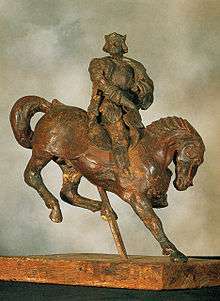Horse and Rider (Leonardo da Vinci)

A beeswax sculpture depicting a rider on a horse was created by Leonardo da Vinci c.1508-1511. It was intended to be used as a model for a larger commissioned sculpture. However, Leonardo died before the model could be cast in bronze. It is thought to be the only surviving example of his sculptural work, known to exist today.[1] Leonardo's right thumb print is imbedded in the wax on the horse's chest.[2]
History
Historians tell us the approximate 10-inch high by 10-inch long sculpture was created as a model for what would have been a commemorative full size bronze sculpture as a tribute to his friend and patron, Charles II d'Amboise who acted as French governor of Milan.[1]
The fragmentary wax sculpture in a private collection in London, formerly in the Sangiorgi Collection([3] in Rome, said to have come from the Melzi estate at Vaprio d'Adda. This according to its last Italian owner, Professor Arturo Bassi[4] of Florence. Attributed as "by Leonardo Himself" by Professor Carlo Pedretti, in 1985. The rider's head bears a striking resemblance to the known portraits of Charles II d'Amboise, French governor of Milan from 1503 to 1511, and Leonardo's patron.[4][5]
This unique piece from a prestigious European collection, a now famous wax model of a horseman, was first published as a work by the great Renaissance master in the corpus of Leonardo’s horse studies in the collection of the Queen of England. It was never seen until this official edition of the newly restored Leonardo papers in the Queen’s Collection at Windsor Castle,[4] a special project entrusted to Carlo Pedretti. The provenance of this small, fragmentary work could well be traced back to the estate of Leonardo’s pupil Francesco Melzi, the inheritor of all Leonardo’s manuscripts and drawings, as well as cartoons and sculptural models.
Charles II d’Amboise was very fond of tournaments, and this equestrian statuette could well portray him in the sort of ceremonial attire that is more appropriate to a statesman than to a military leader. The liveliness of expression and dignity of posture, enhanced as they are by the elegance and nobility of a fluttering cape, taken in conjunctions with the spirited action of the horse, are precisely as expected of Leonardo, whose horse studies from the first decade of the sixteenth century may offer remarkable occasions for comparison with this wax model.[6]
It is well known that Leonardo used wax models to study the compositions of his own paintings. Furthermore, Leonardo was first trained as a sculptor in the workshop of Andrea del Verrocchio in Florence in the early 1470s. But the most convincing piece of evidence in favor of an attribution comes from Leonardo himself. On a sheet of horse studies at Windsor showing figures of horsemen in action for the composition of the Battle of Anghiari, there is a note in his own hand: “Fanne uno piccolo di cera lungo un dito” (have made of wax a finger long). And one of the horses sketched on this folio shows the same bucking position as in the wax statuette.[6][7]
The Wax Horse was displayed publicly at the “Leonardo da Vinci, Scientist, Inventor, Artist” exhibition held in Malmö, Sweden, in 1995,[6] and referenced in the book, titled the same, published on the occasion of the exhibition. Currently, it is believed to be in a private collection in London.[8]
Bronze Sculpture


Over the centuries da Vinci's wax horse had sustained damage, including the loss of one of the horses legs along with the riders feet and hands. In 1985 a mold was made of the wax horse, preserving its then current condition, ensuring the integrity of Leonardo's masterpiece. In 1987 Richard A. Lewis acquired the original mold along with all documentation pertaining to the mold being made.[9] Beginning in 2012, Lewis and a team of experts, "pulled" a wax from the original mold and, using the lost wax process, cast the original Horse and Rider sculpture in bronze.[8][10]
The appearance of the restored masterpiece, cast in bronze, was unveiled to the public on August 27, 2012 at Grey Stone Mansion in Beverly Hills, California, followed by exhibitions in Las Vegas and Dallas.[11] In early 2015 the mold made of Leonardo's wax model, together with the original bronze sculpture, were acquired by a private collector.
In November 2016 Da Vinci Horse and Rider will be exhibited at the Palazzo delle Stelline in Milan, Italy. The exhibition is titled "LEONARDO THE SCULPTOR – HORSE AND RIDER."
References
- 1 2 Stebner, Beth (29 August 2012). "Remarkable 500-year-old Leonardo Da Vinci casting of horse and rider unveiled after original was lost for centuries". Daily Mail. Retrieved 4 February 2014.
- ↑ Solari, Ernesto (2016). Leonardo da Vinci Horse and Rider (1st ed.). Italy: Colibri. p. 91. ISBN 978-88-97206-33-0.
- ↑ "Collezione de Vetri Antichi dalle Origini al V Sec. D.C., ordinati e descriti da Giorgio Sangiorgi con prefazione di W. Froehner (1914)". Original Catalogue of the Giorgio Sangiorgi Collection, sold at CHRISTIES auction. 3 June 1999.
- 1 2 3 "Leonardo da Vinci". In "The collection of HER MAJESTY THE QUEEN". Windsor Castle: 185. 1987.
- ↑ "Achademia Leonardi Vinci". Journal of Leonardo Studies & Bibliography of Vinciana. III: 260–61. 1990.
- 1 2 3 Leonardo da Vinci, Scientist Inventor Artist. 1997. pp. 212–13.
- ↑ Leonardo da Vinci and the Art of Sculpture. 2010. pp. 74–80.
- 1 2 Lewis, Richard A. "Provenance". Leonardo Da Vinci Equestrian LLC. Retrieved 5 February 2014.
- ↑ "Leonardo da Vinci's Horse & Rider Sculpture - Revealed for the First Time in LA". Splash Magazine. 29 August 2012. Retrieved 5 February 2014.
- ↑ "The Casting and Authentication". Leonardo Da Vinci Equestrian LLC. Retrieved 5 February 2014.
- ↑ ""Horse and Rider," Discovered Leonardo Da Vinci Sculpture, To Be Unveiled In Los Angeles". Huffington Post. 14 August 2012. Retrieved 4 February 2014.